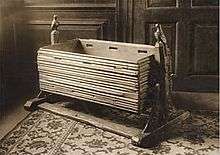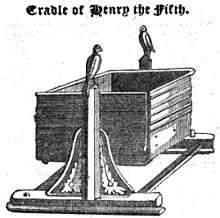Cradle of Henry V
The cradle of Henry V is, according to tradition, the cradle in which the newborn Henry of Monmouth was placed. The cradle was bought at auction by Edward VII, whose successor later gave it to the London Museum. Made of oak, it is now believed to date from a century later than the time of Henry V, but is regarded as a unique example of a medieval cradle made for a baby of noble birth.
| Cradle of Henry V | |
|---|---|
 The cradle of Henry V photographed by William Edward Gray when it was given to the London Museum in 1912 | |
| Material | Wood |
| Present location | Museum of London |
History
The child who was to be Henry V of England was born at Monmouth Castle on 16 September 1386. He was the son of Mary de Bohun and Henry Bolingbroke, and the grandson of John of Gaunt. Monmouth was among Henry of Bolingbroke's possessions and it was where the newly married couple lived for several years. Mary was to die in 1394; Henry Bolingbroke ousted king Richard II and became Henry IV, King of England, in 1399. The young Henry of Monmouth succeeded his father to become King Henry V in 1413.[1]

During the 18th and early 19th centuries the cradle was famous locally and its claim to be a genuine relic of Henry V's childhood was generally accepted.[2] It was private property, though often shown to visitors. In 1839 it was said to have been in the possession of the antiquarian George Weare Braikenridge, of Brislington, Bristol, who was reported to have bought it for £30.[3][4] In 1872, the cradle, together with the armour that Henry V allegedly wore at Agincourt, were said to be at Troy House in Mitchel Troy.[5] Its location was reported by William Watkins Old, of Monmouth to the Royal Historical Society in 1876.[6]
The cradle was auctioned at Christie's in London in 1908 and was bought for 230 guineas by Guy Laking, King Edward VII's armourer, bidding on behalf of the King himself.[7] The cradle then went to Windsor Castle and remained there for four years. In 1912 the London Museum was established at Kensington Palace under Guy Laking's direction, and the cradle was given to the Museum by Edward VII's successor, King George V.[8] The London Museum, now known as the Museum of London, moved to its current site at the Barbican in 1950.
The cradle, made of oak and with two heraldic birds watching over a suspended crib, is still in the Museum of London. It is now believed to date from the late 15th century, and is a unique example of a mediaeval cradle made for a baby of noble birth. However, it post-dates the time of Henry V.[9]
References
- Biography of HENRY V - Archontology.org. Retrieved 29-3-2012
- Mirror of Literature vol. 5 no. 121 (1 January 1825) p. 9
- Craik, George L. (1839). The pictorial history of England: being a history of the people as well a history of the kingdom: p.238. Kight & Co.
- Magpie's nest of antiquities catches city before cameras, ThisIsBath.co.uk, 19 October 2010. Accessed 13 April 2012
- Wilson, John Marius (1872). Descriptive Imperial Gazetteer of England and Wales: Entry for MONMOUTH.
- William Watkins Old (1876)
- Wanganui Chronicle (16 April 1908) Text
- Kentucky New Era (4 June 1912) Report and illustration
- Caption at AgeFotostock.com Archived 2012-07-31 at Archive.today. Accessed 13 April 2012
Further reading
- William Watkins Old, "Historical Notices of the Cradle of Henry V" in Transactions of the Royal Historical Society vol. 4 (1876) pp. 231–259
- Aymer Vallance, "Early Furniture, XV: Cradles and Beds" in Burlington Magazine vol. 24 (1914) pp. 288–289, 292-293